The State of Beauty among Indonesian Women in Their 20s: The Customer Journey of the Digital Native Generation in Cosmetics -Asia Insight Report
- Release date: Jun 15, 2018
- 5037 Views
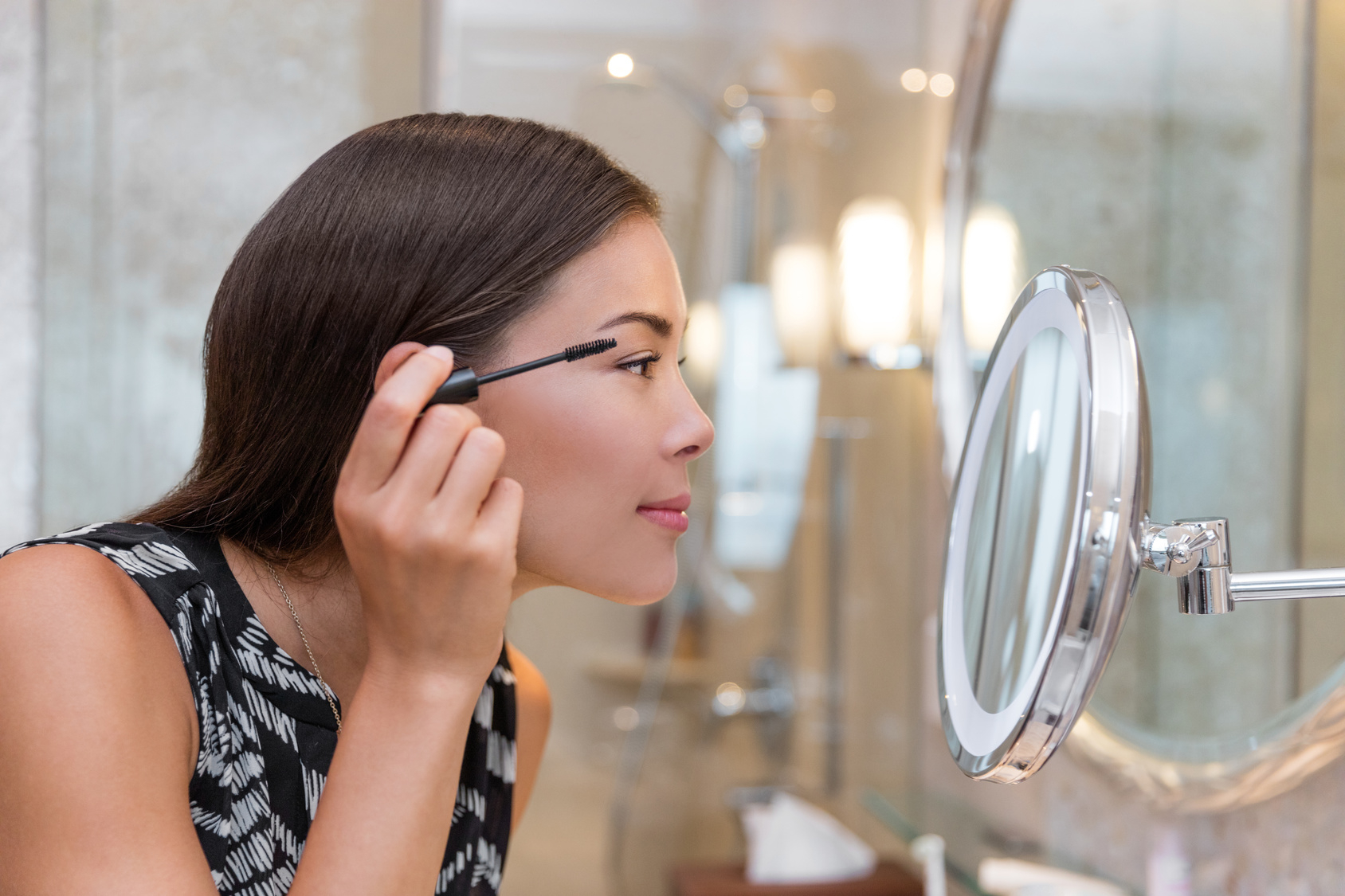
In addition to the results of the second Asia Insight Research survey in 2017 and the MyReco® smartphone-based diary survey, both of which are conducted to understand the values and living conditions of sei-katsu-sha in Asian cities, this article also provides an overview of the activities of Intage Group members in Indonesia. In addition to the results of the second Asia Insight Research survey in 2017 and MyReco®, a smartphone-based diary survey, we will introduce the current situation in Indonesia through the insights of Intage Group members who are active in Indonesia.
What cosmetics do women in their 20s use in Jakarta?
First, let's take a look at what kind of cosmetics they usually use. Chart 1 shows the percentage of respondents who use cosmetics on a daily basis. In order of usage, 88% use face powder, 76% use lipstick, and 54% use foundation.Chart 1 ●Usual use of cosmetics

Foundation Users = Firm Makeup?
Looking at the survey results in detail, we found that the use of cosmetics in general differs greatly depending on whether or not foundation is used. As shown in Chart 2, those who use foundation have a higher usage rate of all cosmetic items than non-users, and the average number of cosmetic items used per person is 8.1, which is higher than the average of 3.9 for non-users.Chart 2 ●Daily use of cosmetics (Comparison between foundation users and non-users)
What are the characteristics of the two types of makeup?
Based on the results of Asia Insight Research's second survey in 2017, the following is a summary of the characteristics of the two groups (Chart 3).Chart 3 ●The firm makeup group vs. the natural makeup group

The natural makeup group uses face powder for base makeup and lipstick for point makeup. In addition to the fact that natural makeup is popular in Indonesia, there may be a religious reason why they wash their face every time they pray six times a day. In addition, many natural makeup wearers use motorcycles as their means of transportation. With air pollution as well as traffic congestion becoming more serious, they may decide to use the minimum amount of makeup from the beginning if it is going to fall off even after taking the time to apply it.
Japanese women use multiple cosmetics such as foundation and eye makeup products to painstakingly complete their natural makeup, but for Indonesian women, it seems to mean using only a few cosmetics to create a look similar to that of a bare face.
What information sources do you refer to when purchasing cosmetics? Those who like to wear makeup well also use digital and social media.
Let's take a look at the sources of information used by both the firm makeup group and the natural makeup group when purchasing cosmetics (Figure 4). The most popular source of information for both the firm and natural makeup groups is TV commercials, and the second most popular source is word of mouth from friends and family. Digital/social media and advertisements, such as online advertisements on YouTube and SNS and blogs of friends, acquaintances and celebrities, also ranked high, but still not as high as TV commercials and real word of mouth. However, they are still not as popular as TV commercials and real word of mouth.Comparing the "firm makeup" group with the "natural makeup" group, the "firm makeup" group seems to be using more information sources to gather information spontaneously. Those in the firm make-up group are more than 10 points higher than those in the natural make-up group in referring to "company websites," "company SNS and blogs," "TV program introductions," and "newspapers and magazines. In addition, those in the firm make-up group use a wide range of information sources to gather information on cosmetics, including "SNS and blogs of friends, acquaintances and celebrities" and "evaluations on word-of-mouth sites.
Chart 4
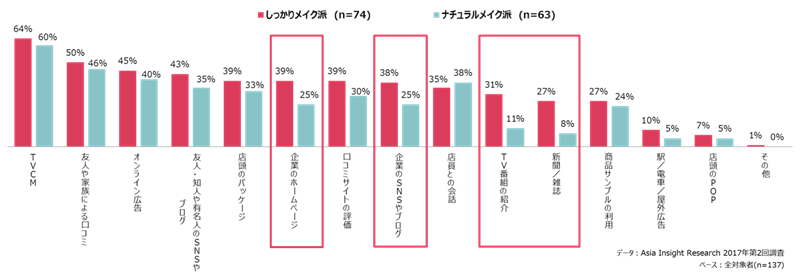
The customer journey to purchase cosmetics Information sources used as reference when purchasing cosmetics
Next, we introduce the customer journey to purchase cosmetics for the firm makeup group and the natural makeup group, as captured by MyReco, a smartphone-based diary survey. 51 women in their 20s living in Jakarta were asked to use MyReco to record their contact information and purchases of cosmetics during the month of January 6 to February 5, 2018. We asked 51 women in their 20s living in Jakarta to record their information contact and purchases of cosmetics using MyReco. Here are the journeys of Ms. A (Figures 5 and 6), who is a firm makeup wearer, and Ms. B (Figures 7 and 8), who is a natural makeup wearer.Firmly made up type A
Figure 5 ●Makeup artist A Profile
Chart 6 ●The customer journey from information contact about cosmetics to purchase
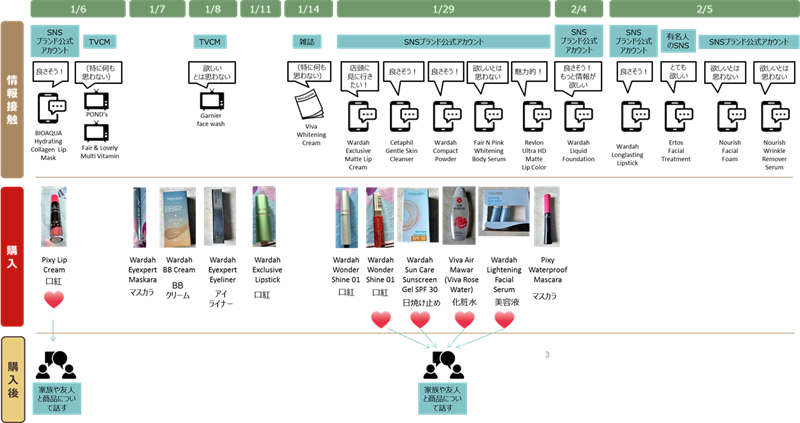
She uses TV commercials and magazines as an opportunity to learn about products, and when she needs more information, she uses SNS. In her normal information acquisition behavior, she also reads friends' and acquaintances' SNS and blogs, but in the past month, she has been referring to manufacturers' explanations and word of mouth from celebrities. Finally, it seems to be a natural flow for Ms. A to go to a store to see the product for herself and purchase the product.
Next, let's take a look at the products she purchased. All of them were purchased at cosmetics stores. Most of the products she purchased were from Wardah, and she chose cosmetics that were halal and suitable for her sensitive skin. Wardah is a special brand for her because it meets both of these requirements. She has experienced skin irritation from other brands in the past, so she is very cautious about gathering information before trying new cosmetics. Once she finds a brand that she likes, she will actively try out the cosmetics of that brand.
She purchased several cosmetics on January 29th. Before purchasing the cosmetics, she checked the product information on SNS, and even after the purchase, when she returned home, she started gathering information about the cosmetics she was interested in at the store. Also, of the 11 products she purchased, Ms. A talked with her family and friends about the 5 products she liked the feel of on the day she purchased them.
Now, let's take a closer look at Ms. B, a natural makeup artist.
Natural makeup type B
Figure 7 ●Natural makeup artist Ms. B Profile
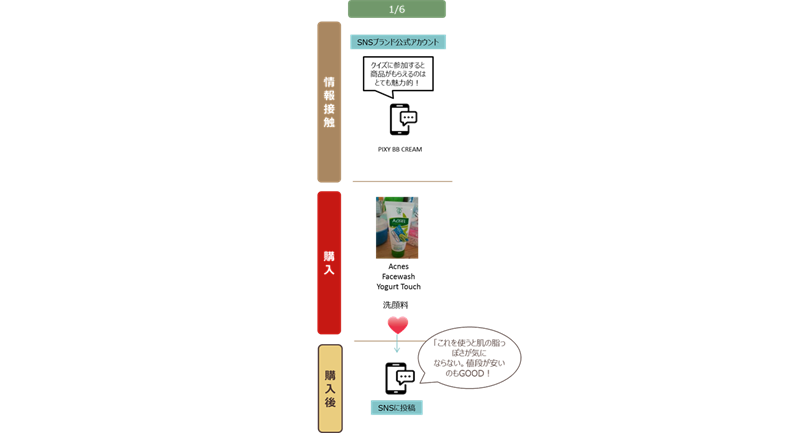
Like Ms. A, Ms. B came into contact with the social networking service (SNS) of a cosmetics brand, which was running a campaign to give away BB creams by participating in a quiz. Although she did not purchase any BB creams during the month of the survey, it seemed to be an opportunity for her to become interested in a new product.
Next, let's take a look at the products purchased by Ms. B. She had purchased Acnes products in the past, and purchased them again at a department store/mall. Ms. B's skin problem is oily skin, and the Acnes facial cleanser is known to be effective in preventing acne. According to Ms. B, even though she is interested in new products, she finds it difficult to buy other products. Also, Ms. B posted her impressions of the facial cleanser she purchased on social media that day.
Is it common practice for Indonesian women to share their impressions after a purchase?
As mentioned above, Ms. A shared her impressions of some of the products she purchased with her family and friends. Mr. B also posted his impressions of the products on SNS. In this way, is it common for people in Indonesia to share their impressions of products they have purchased? Let's take a look at what actions the subjects of this survey took after their purchases.Of the 51 women who cooperated in this diary-style survey, 25 purchased products during the one-month survey period. Some of them, like Ms. A, purchased more than one product, so the total number of products purchased was 48. Looking at the actions taken after the purchase of these 48 products, we found that about three quarters of the products were discussed with family or friends (Figure 9).
It seems that not only Ms. A, but all the women in their 20s who cooperated in this survey often share their impressions of the products they purchased with their family and friends. ●Actions after purchasing cosmetics
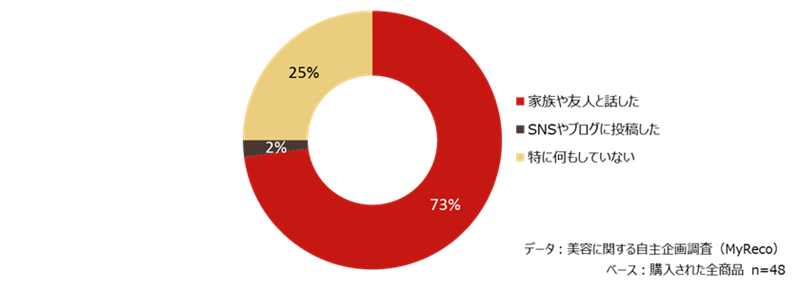
In addition, there are still low-quality products and counterfeit products with similar packaging available in Indonesia. In addition, in Jakarta, where traffic congestion is serious, it is difficult to casually drop by a store after work and do some shopping like in Japan. The fact that women in their twenties in Jakarta seem to be digital natives, using digital and social media to gather information and exchange information with those around them on a daily basis, may be a sign that they want to purchase products after thorough preparation in order to avoid making mistakes when shopping. Translated with AI Translator
-

Author profile
Intage Inc
***
-

Editor profile
Intage Inc.
***
 Global Market Surfer
Global Market Surfer CLP
CLP